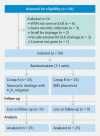Management of walled-off necrosis with nasocystic irrigation with hydrogen peroxide versus biflanged metal stent: randomized controlled trial
- PMID: 34222637
- PMCID: PMC8216781
- DOI: 10.1055/a-1480-7115
Management of walled-off necrosis with nasocystic irrigation with hydrogen peroxide versus biflanged metal stent: randomized controlled trial
Abstract
Background and study aims Walled-off necrosis (WON) is a known complication of acute necrotizing pancreatitis (ANP). There is no study comparing nasocystic irrigation with hydrogen peroxide (H 2 O 2 ) versus biflanged metal stent (BMS) in the management of WON. The aim of this study was to compare the clinical efficacy of both the treatment strategies. Patients and methods This study was conducted on patients with symptomatic WON who were randomized to nasocystic irrigation with H 2 O 2 (Group A) and BMS placement (Group B). Primary outcomes were clinical and technical success while secondary outcomes were procedure time, adverse events, need for additional procedures, duration of hospitalization, and mortality. Results Fifty patients were randomized into two groups. Group A (n = 25, age 37.8 ± 17.6 years, 16 men) and Group B (n = 25, age 41.8 ± 15.2 years, 17 men). There were no significant differences in baseline characteristics between the two groups. The most common etiology of pancreatitis was alcohol, observed in 27 (54 %) patients. Technical success (100 % vs 96 %, P = 0.98), clinical success (84 % vs 76 %, P = 0.76), requirement of additional procedures (16 % vs 24 %, P = 0.70) and adverse events (4 vs 7, P = 0.06) were comparable in both the groups. The duration to clinical success (34.4 ± 12 vs 14.8 ± 10.8 days, P = 0.001) and procedure time (36 ± 15 vs 18 ± 12 minutes, P = 0.01) were longer in Group A compared to Group B. Conclusions Nasocystic irrigation with H 2 O 2 and BMS are equally effective in the management of WON but time to clinical success and procedure time is longer with nasocystic irrigation.
The Author(s). This is an open access article published by Thieme under the terms of the Creative Commons Attribution-NonDerivative-NonCommercial License, permitting copying and reproduction so long as the original work is given appropriate credit. Contents may not be used for commercial purposes, or adapted, remixed, transformed or built upon. (https://creativecommons.org/licenses/by-nc-nd/4.0/).
Conflict of interest statement
Competing interests The authors declare that they have no conflict of interest.
Figures


References
-
- Banks P A, Bollen T L, Dervenis C et al.Classification of acute pancreatitis--2012: revision of the Atlanta classification and definitions by international consensus. Gut. 2013;62:102–111. - PubMed
-
- Varadarajulu S, Rana S S, Bhasin D K. Endoscopic therapy for pancreatic duct leaks and disruptions. Gastrointest Endosc Clin N Am. 2013;23:863–892. - PubMed
-
- Bang J Y, Hawes R, Bartolucci A et al.Efficacy of metal and plastic stents for transmural drainage of pancreatic fluid collections: A systematic review. Dig Endosc. 2015;27:486–498. - PubMed
LinkOut - more resources
Full Text Sources

